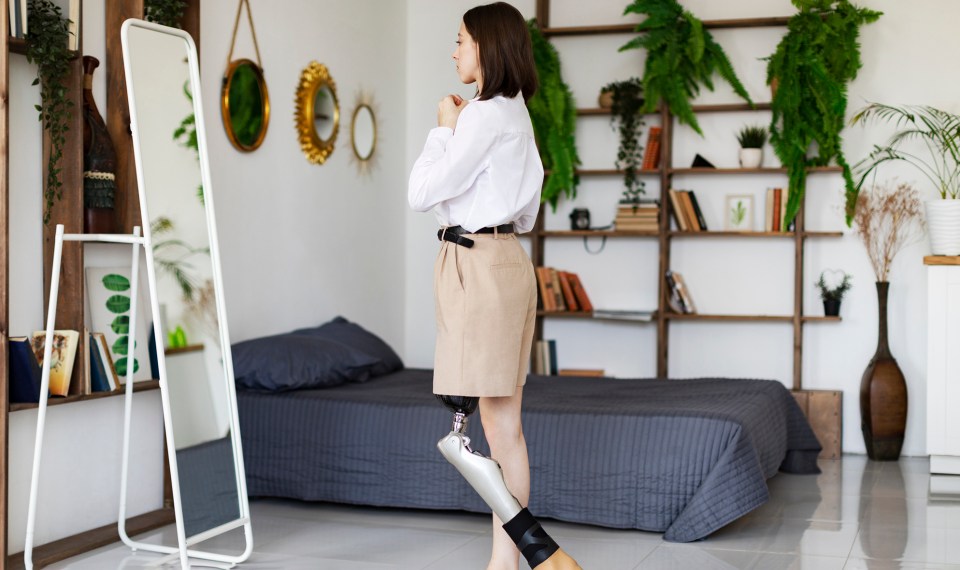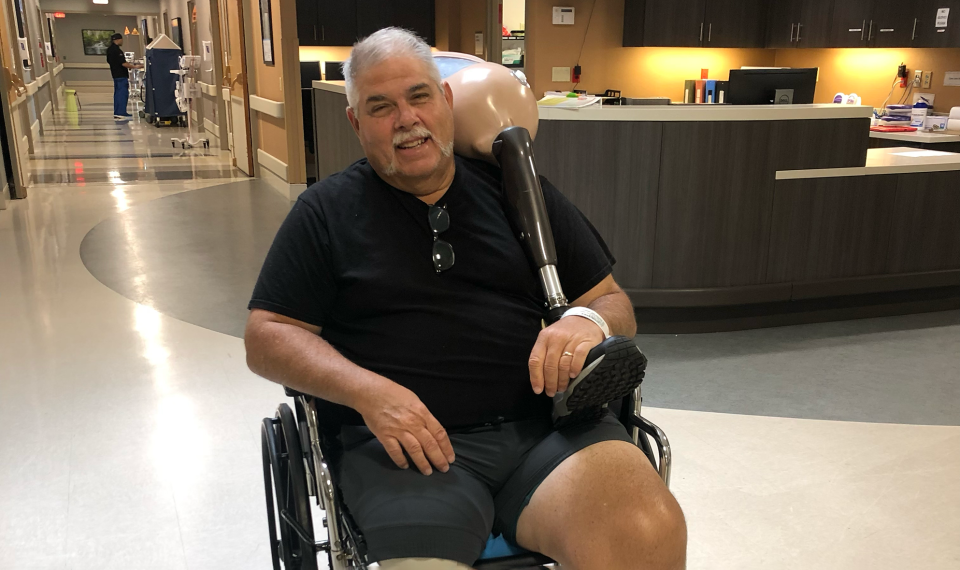After an amputation, your doctor may recommend you go to inpatient rehabilitation. In the early stages of recovery from limb loss, inpatient rehab can help you care for your wound, while also helping you adjust to life after amputation. You may also benefit from a second rehabilitation stay once you receive your prosthetic. Prosthetic training can help you manage and use your new limb to your greatest ability.
“One of the biggest knowledge gaps is the timeline from amputation to prosthetic; most amputees assume they will receive their prosthetic within a couple of days/weeks,” said Megan Lopez, senior physical therapist and amputee team lead at Encompass Health, a partner of Washington Regional Medical Center. “You can’t be fitted for a prosthetic until swelling is down and the sutures are removed. That can take anywhere from two to four months.”
What to Expect After an Amputation
After a significant amputation, such as a below-the-knee leg amputation, you will likely spend three to five days in the acute hospital before transitioning to a rehabilitation hospital, such as Encompass Health. In this setting, you will receive a combination of physical and occupational therapy. You will also receive medical care from rehabilitation nurses and physicians to care for your wound and manage pain.
If you haven’t been fitted with a rigid removable dressing, also known as an RRD, at the acute hospital, you will be in the rehab setting. This will help control swelling and muscle contractures, Lopez said.
During your initial rehabilitation stay, your therapy will focus on range of motion, stretching and pain management and could use any of the following techniques:
- Electrical stimulation
- Gentle tapping of the residual limb
- Mirror therapy
- Massage
- Range of motion exercises
- Deep oscillation, a technique that uses vibration to stimulate the affected tissues
If you are recovering from a lower limb amputation, your physical therapist will also work with you on mobility from using a wheelchair to transitioning to a walker.
“We’re going to try and get you as independent as we can,” Lopez said. “We’re going to focus on strengthening and mobility, and if possible, we’ll work on early hopping with a walker.”
Being Fitted for a Prosthetic
Your initial rehabilitation stay after surgery is typically about two weeks. Once your wound has healed and the sutures are removed, you can begin the process of being fitted for a prosthetic.
Learning to use the prosthesis and integrating it into your daily routine enhances function and improves overall quality of life. This is where a second inpatient rehabilitation stay could help, Lopez said.
“First, you will trial your new prosthetic with a prosthetist, and they can recommend you for inpatient rehabilitation, where you can do prosthetic training,” she said. “The best benefit to that is you’ll have an interdisciplinary team. Your physical therapist is trained in prosthetic training and will work with your prosthetist.”
Are You a Candidate for Rehab
Encompass Health is a leading provider in inpatient rehabilitation. With more than a 160 locations nationwide, we can help you in your recovery after an illness, injury or surgery.
Find a LocationProsthetic Therapy and Training
The rehabilitation process for amputation is complex, requiring a multidisciplinary approach. In addition to physical therapy, your care team will also include rehabilitation physicians and nurses, occupational therapists and more.
“In inpatient rehabilitation, we’re looking at the whole picture,” Lopez said. “There is usually something more than just the amputation; they could have kidney disease and could be on dialysis. We can help manage all those things. We work as a team to find the right care plan and length of stay.”
In the case of an arm amputation, your therapists will design a plan to stretch the shoulder and elbow and strengthen arm muscles. You will learn to perform activities of daily living using the prosthesis and possibly adaptive devices and other body parts.
Lower limb prosthesis therapy focuses on conditioning and exercises to stretch the hip and knee, strengthen arm and leg muscles, and work on standing, balancing and endurance.
Your therapists will also work with you to learn how to put on and remove the prosthesis, how to walk with it (if lower limb) and how to care for both the prosthesis and the residual limb. Skin integrity is especially important. Keeping the skin clean and dry and inspecting for signs of irritation and breakdown will become part of your daily routine. Other skills your therapists may focus on include using stairs, walking up and down hills, navigating uneven surfaces and possibly even participating in athletic activities.
“We’ll create a wearing schedule to help you adjust to the new limb and get used to taking it on and off,” Lopez said. “We’ll also do skin checks and show you what to look for.”
Emotional and Psychological Support
The loss of a limb is life-altering. In addition to the physical challenges, it can impact your mental health. It is common to feel a variety of emotions throughout the recovery process. Pain, changes in body image, a lengthy recovery timeline and the trauma of surgery itself all have emotional consequences. Prosthetic therapy can help with the psychological impact of this profound change and can start you on the road to regaining your independence.
As part of your inpatient rehabilitation stay, a case manager will work with you to identify resources in your community and connect you and your loved ones with support groups. Many rehabilitation hospitals have their own support groups that you can attend during and after your rehabilitation stay.
Other coping techniques that could be helpful include:
- Acknowledging that it is normal to feel a wide range of emotions including grief, frustration, sadness and anger. Recognizing these feelings is the first step in managing them.
- Establishing a daily routine. Completing routine tasks provides a distraction and keeps you from focusing on the negative. It also offers a much-needed structure and sense of purpose.
- Talking with a mental health professional who can offer coping techniques and help you deal with your emotions in a constructive way. Being open with family members and friends about your feelings can help them understand your feelings and provide needed support.
- Celebrating small achievements. Working toward realistic goals gives you an opportunity to achieve success and allows you to focus on something productive.
Learning a new way of doing things isn’t easy, but it can help you reach maximum functional independence. Throughout your recovery you may experience setbacks, but sticking with your prosthetic therapy program can improve circulation, help you avoid unnecessary complications and learn to use your prosthesis to its full capacity.
The content of this site is for informational purposes only and should not be taken as professional medical advice. Always seek the advice of your physician or other qualified healthcare provider with any questions you may have regarding any medical conditions or treatments.



